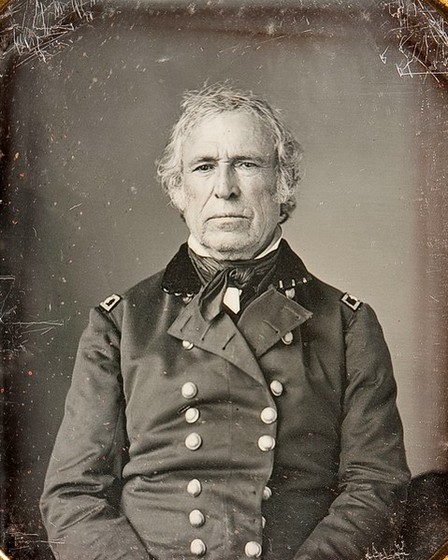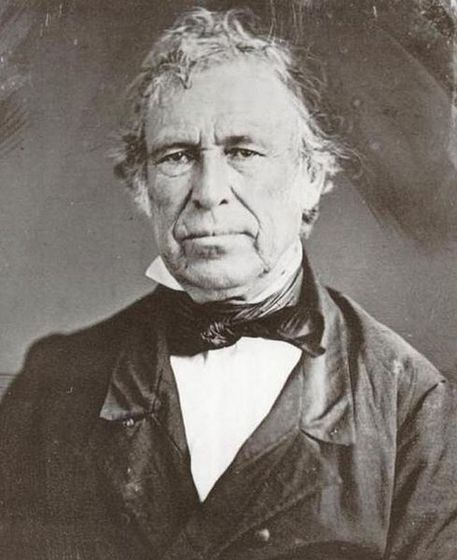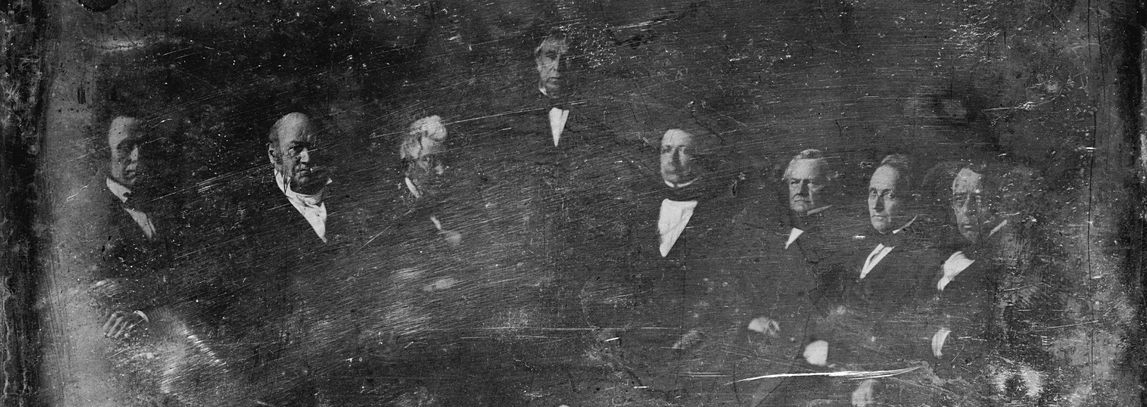|
President Zachary Taylor
| Zachary Taylor |

|
| President Zachary Taylor, ca. 1844. |
| President Zachary Taylor |

|
| President Zachary Taylor, ca. 1850. |
12th President of the United States (1849–1850)
| Born: |
Nov. 24, 1784, in Orange County, Va. |
| Higher Education: |
None. |
| Religious Affiliation: |
Episcopalian. |
| Occupation: |
Soldier. |
| Marriage: |
June 21, 1810, to Margaret Mackall Smith (1788–1852). |
| Children: |
Ann Mackall (1811–1875); Sarah Knox (1814–1835); Octavia
Pannel (1816–1820); Margaret Smith (1819–1820); Mary Elizabeth (1824–1909); Richard (1826–1879). |
| Military Service: |
U.S. Army (1808–1849), War of 1812, Seminole War, Black
Hawk War, Mexican War. |
| Party Affiliation: |
Whig. |
| Legal Residence When Elected: |
Louisiana. |
| Position before Taking Office: |
Major general, U.S. Army. |
| Died: |
July 9, 1850, in Washington, D.C., at age 65. |
| Burial Place: |
Zachary Taylor National Cemetery, near Louisville, Ky. |
| President Zachary Taylor and Administration |

|
| President Zachary Taylor and Cabinet |
(About) President Taylor and his Cabinet. From left to right: William B.
Preston, Thomas Ewing, John M. Clayton, Zachary Taylor, William M. Meredith, George W. Crawford, Jacob Collamer and Reverdy
Johnson, (1849). President Zachary Taylor's cabinet, 1849 daguerreotype by Mathew Brady, Library of Congress.
| Office |
Name |
Term |
| Vice President |
Millard Fillmore |
1849–1850 |
| Secretary of State |
James Buchanan |
1849 |
|
John M. Clayton |
1849–1850 |
| Secretary of the Treasury |
Robert J. Walker |
1849 |
|
William M. Meredith |
1849–1850 |
| Secretary of War |
William L. Marcy |
1849 |
|
George W. Crawford |
1849–1850 |
| Attorney General |
Isaac Toucey |
1849 |
|
Reverdy Johnson |
1849–1850 |
| Postmaster General |
Cave Johnson |
1849 |
|
Jacob Collamer |
1849–1850 |
| Secretary of the Navy |
John Y. Mason |
1849 |
|
William B. Preston |
1849–1850 |
| Secretary of the Interior |
Thomas Ewing |
1849–1850 |
Source: Encyclopedia Americana
Recommended Reading: Zachary Taylor:
Soldier, Planter, Statesman of the Old Southwest. Description: Zachary Taylor was one of the most unlikely men to ever serve as president of the United States. Self-educated, an average and conservative
military leader, considered by many to be less than intellectual, but General Zachary Taylor, affectionately referred to as
the soldier’s soldier, was thrust into the limelight because of his success in the Mexican War. Although a southerner,
Taylor opposed the extension of slavery and threatened dire
consequences to secessionists. (Ironically, his son, Richard Taylor, became one of the South’s greatest Civil War generals.)
Continued below...
He died unexpectedly
after serving only sixteen months as president. His death occurred just as he was reorganizing his administration and attempting
a recasting of the Whig Party. Mr. Bauer does a good job of describing the effect that Zachary Taylor had on the nation as
well as that “personal side” of the soldier’s soldier.
Recommended
Reading: The Presidencies of Zachary Taylor and Millard Fillmore (American Presidency Series) (Hardcover) (University
Press of Kansas). Description: In this book, Elbert B. Smith sharply disagrees with traditional interpretations of Taylor
and Fillmore, the twelfth and thirteenth presidents (from 1848 to 1853). He persuasively argues that the slaveholding Taylor--and
not John C. Calhoun--was the realistic defender of southern slaveholding interests, and that Taylor
did nothing to impede the Compromise of 1850. While Taylor
opposed the combination of the issues into a single compromise bill that could not be passed without amendments to suit the
extremists, he would have approved the different parts of the Compromise that were ultimately passed as separate measures.
Continued below...
Most historians have written that Taylor's death and Fillmore's accession
led to an abrupt change in presidential policy, but Smith believes that continuity predominated. Taylor wanted the controversies
debated and acted upon as separate bills; Fillmore helped to accomplish it. Taylor had desired statehood for California and
New Mexico with self-determination, or popular sovereignty, on slavery. As separate measures, the Congress admitted California
and preserved a viable New Mexico as a “territory authorized to make its own decision on slavery.” With secessionists
pitted against moderates in the southern elections of 1851, Fillmore had to choose between his constitutional oath and his
personal antipathy to the new fugitive slave law. He supported the law and thereby helped keep southern moderates in power
for a few more years. In fact, however, his efforts did not recapture a single slave. In Smith's view, Fillmore's most serious
mistake was refusing a second term. Smith argues that Taylor and Fillmore have been seriously misrepresented and underrated.
They faced a terrible national crisis and accepted every responsibility without flinching or directing blame toward anyone
else.
Recommended
Reading: Zachary Taylor: The 12th President,
1849-1850 (The American Presidents) (Hardcover). Description: The rough-hewn general
who rose to the nation’s highest office, and whose presidency witnessed the first political skirmishes that would lead
to the Civil War. Zachary Taylor was a soldier’s soldier, a man who lived up to his nickname, “Old Rough and Ready.”
Having risen through the ranks of the U.S. Army, he achieved his greatest success in the Mexican War, propelling him to the
nation’s highest office in the election of 1848. He was the first man to have been elected president without having
held a lower political office. John S. D. Eisenhower, the son of another soldier-president, shows how Taylor rose to the presidency, where he confronted the most contentious political issue of
his age: slavery. Continued below...
The political
storm reached a crescendo in 1849, when California, newly populated after the Gold Rush, applied for statehood with an anti-slavery constitution,
an event that upset the delicate balance of slave and free states
and pushed both sides to the brink. As the acrimonious debate intensified, Taylor stood his
ground in favor of California’s admission—despite
being a slaveholder himself—but in July 1850 he unexpectedly took ill, and within a week he was dead. His truncated
presidency had exposed the fateful rift that would soon tear the country apart.
Recommended
Reading: President Zachary Taylor: The Hero President (First Men, America's Presidents) (Hardcover).
Description: Zachary Taylor (November 24, 1784 - July 9, 1850) was an American military leader and the twelfth President of
the United States.
Taylor had a 40-year military career in the U.S. Army, serving
in the War of 1812, Black Hawk War, and Second Seminole War before achieving fame while leading U.S.
troops to victory at several critical battles of the Mexican-American War. Continued below…
Taylor's short Presidency was shadowed by the issue then dominating all
aspects of American national affairs - that of slavery. However, the immediate issue was the admission of New Mexico and California as states. Taylor confounded his Southern
supporters, who had assumed that since the President owned slaves, he would support the pro-slavery position and refuse entry
into the union to two states settled by Northerners and likely to be anti-slavery. Taylor recommended that the two territories develop
their own constitutions and then request admission based on those constitutions. When Southern states threatened secession
he warned them that he would use all his resources as commander-in- chief to preserve the union. He stated that if they seceded
he would track them down like he had the Mexicans, and handle them in the same manner that he had deserters. Taylor's brief term in the
White House also featured the still on-going question of balancing power between the Congress and the presidency.
Recommended
Reading: Letters Of Zachary Taylor From The Battlefields Of The Mexican War (1908). Review: If you are interested in this influential episode of US
history, this book conveys it straight from the proverbial horse’s mouth. In contrast with often one-sided accounts
like President Polk's and others’ memoirs, this book displays the human side of the invasion of Mexico.
General Taylor reveals that he was conflicted in many standpoints ranging from ethical to military and political. Although
he understood that it was his duty to serve his country and fight in a war against the weaker neighbor, Mexico, he shows us an emotional and personal
side rarely seen in America’s
top brass.
|

